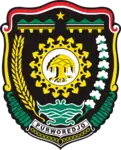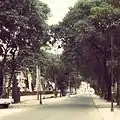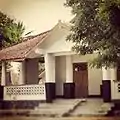Purworejo Regency
Purworejo is a regency (Indonesian: kabupaten) in the southern part of Central Java province in Indonesia. It covers an area of 1,034.82 km2 and had a population of 695,427 at the 2010 Census;.[2] the latest official estimate (as at mid 2019) is 718,316.[3] Its capital is the town of Purworejo.
Purworejo Regency
Kabupaten Purworejo | |
|---|---|
 Coat of arms | |
| Motto(s): Purworejo Berirama
(Bersih, Indah, Rapi, Aman, dan Makmur) (Clean, Lovely, Tidy, Safe, and Palmy) | |
 | |
| Country | |
| Province | Central Java |
| Seat | Purworejo |
| Area | |
| • Total | 1,034.82 km2 (399.55 sq mi) |
| Population (mid 2019)[1]</ref> | |
| • Total | 718,316 |
| • Density | 690/km2 (1,800/sq mi) |
| Time zone | UTC+7 |
| Website | purworejokab |
History
Ancient Mataram Hindu Period (8th–9th century AD)
The history of Purworejo is first recorded on Kayu Ara Hiwang inscription on 5 October 901, which is being found in Boro Wetan Village.[4] The area was originally known by the name 'Bagelen' (read /ba·gə·lɛn/) and it is now become a smaller part of the whole Purworejo regency.
In the 9th centuries, Bagelen is part of the history of the ancient Mataram Hindu civilization (See: Medang Kingdom) which was flourished on Kedu Plain. It is estimated that within the period of Rakai Watukara Dyah Balitung, Bagelen had become the capital of the Mataram Hindu Kingdom or that it is the origin of the king as Watukara is a river name in Bagelen.
The ancient artifact being found in Bagelen is Kayu Ara Hiwang inscription which explain Shima ceremony. At that period, when a new land is being opened for economic or religious use, there will be a ceremony being held by the authorities, namely Shima ceremony. The authorities mentioned in the inscription are: Sang Ratu Bajra, who is allegedly as Rakryan Mahamantri/Mapatih Hino Sri Daksottama Bahubajrapratipaksaya, who is also the brother-in-law of Rakai Watukura Dyah Balitung and who is also later became Balitung's successor.
The ceremony mentions that the land is being freed from any tax duty, but it has the obligation to maintain the holiness of a sacred place called "parahiyangan" (which means the place of Gods). The ceremony also purified the area of Kayu Ara Hiwang of any evil's influence. Kayu Ara Hiwang area itself consists of rice fields, savanna, caves and arable land. The cave mentioned in the inscription is identified as Seplawan Cave, where a shiva gold statue is being found and therefore the second artifact within Bagelen area.
Within this period, Bagelen became a religious center where some Buddhist monks (and often skilled with martial arts) were probably lived along the Bogowonto river banks.
Mataram Sultanate (Muslim) Period (15th–16th century AD)
During this period, the people of Bagelen is famous for becoming the special arms force for Sutawijaya, hence the beginning of its militaristic character which also said as inheritance of the martial art skills being instilled by the previous Buddhist monks from the ancient Mataram period.
Dutch Colonial Period (16th–19th century AD)
During this period, Bagelen area was notorious of its powerful insurgent which support Prince Diponegoro throughout Java War. Upon the defeat of Diponegoro, Bagelen was being asked from Mataram Sultanate in order to undermine the power of Bagelen's insurgent and was being integrated into Kedu Residency by the Dutch Colonial ruler. The new town, called Poerworedjo (new spelling: Purworejo) is being designed by a Dutch architect by adopting traditional Javanese architecture and tradition. The Dutch implemented indirect rule, which is reflected in its town architecture, where the regent is from the local leader (Raden Adipati Cokronegoro Pertama) and the co-ruler (the regent assistant) is always a Dutch. This new town was also served as Dutch military base camp which housed the Dutch Black Colonial Armed Forces from West Africa. Some Dutch residents were born, lived and died in Purworejo, the records can be found in The Civil Registry of the Dutch East-Indies.[5]
Some Dutch colonial buildings are still in a good shape until now as of Regency Official House (1840), a church which still become GPIB Church (1879), Kweekschool (1915), Train Station, Bank, Hospital. During this period, there were 2 main religious figures: a Muslim preacher (mubaligh) kyai Imam Pura and a Javanese Christian Evangelist, Kyai Sadrach. This is the evidence that in Purworejo, Muslim and Christians are being accepted harmoniously by its people.
Modern Indonesian period
In the modern day Indonesia, Purworejo produce skilled work force in the area of government, education and military. The prominent general from Purworejo is Sarwo Edhie Wibowo who is also the father-in-law of President Susilo Bambang Yudhoyono. There are also several other notable general arms forces, government officials, ministers and lecturers as being listed in the notables from Purworejo.
Purworejo is recently more well known as the town of retirement. As the economic and government activities of modern Indonesia is centered in Jakarta, the majority of Purworejo citizens are urged to work in Jakarta or in other parts of Indonesia or even worldwide. However, there is also an urge for Purworejo citizen to repatriate and to build retirement residences in Purworejo. Because of its reputation as a retirement town in the modern day, its inheritance as a Dutch town and its ancient inheritance of Buddhist religious center, Purworejo is relatively a peaceful town with vast main roads, big old trees on both sides, regular squares of town blocks and its preserved Dutch buildings. The wider area of Purworejo Regency mainly has agriculture and livestock activities while some medium-sized, export oriented industrial activities (traditional furniture, textile and sports equipment) is being established in the southern part of the region.
Administrative districts
Purworejo Regency is divided into the following sixteen districts (kecamatan), tabulated below with their areas and their populations at the 2010 Census,[6] together with the latest official estimates (for mid 2019).[7] The table also includes the number of administrative villages (rural desa and urban kelurahan) in each district and its post code.
| District | Area in km2 | Population 2010 Census | Population 2019 Estimate | Number of Villages | Post code | |
|---|---|---|---|---|---|---|
| Grabag | 64.92 | 42,634 | 44,035 | 32 | 54265 | |
| Ngombol | 55.27 | 30,779 | 31,790 | 57 | 54172 | |
| Purwodadi | 53.96 | 36,435 | 37,633 | 40 | 54173 | |
| Bagelen | 63.76 | 28,708 | 29,652 | 17 | 54174 | |
| Kaligesing | 74.73 | 29,107 | 30,063 | 21 | 54175 | |
| Purworejo (district) | 52.72 | 82,904 | 85,640 | 25 | 54112 -54119(a) | |
| Banyuurip | 45.08 | 39,983 | 41,308 | 27 | 54171 | |
| Bayan | 43.21 | 45,636 | 47,146 | 26 | 54222 -54224 | |
| Kutoarjo | 37.59 | 58,176 | 60,088 | 27 | 54211 -54214(b) | |
| Butuh | 46.08 | 38,787 | 40063 | 41 | 54264(c) | |
| Pituruh | 77.42 | 45,667 | 47,168 | 49 | 54263 | |
| Kemiri | 92.05 | 50,611 | 52,274 | 40 | 54262 | |
| Bruno | 108.43 | 43,274 | 44,696 | 18 | 54261 | |
| Gebang | 71.86 | 39,829 | 41,138 | 25 | 54191(d) | |
| Loano | 53.65 | 34,545 | 35,680 | 21 | 54181 | |
| Bener | 94.08 | 48,352 | 49,942 | 28 | 54183 | |
| Totals | 1,034.82 | 695,427 | 718,316 | 494 |
Notes: (a) except the kelurahan of Purworejo, which has a post code of 54151.
(b) except the kelurahan of Kutoarjo, which has a post code of 54251.
(c) except the village of Kedungsari, which has a post code of 54116.
(d) except the village of Kemiri, which has a post code of 54262.
Transportation
Airport
The airport closest to the town is Adisucipto International Airport which is approximately within 1.5 hours driving distance. With the development of Yogyakarta International Airport near the border of Jogjakarta and Purworejo, it will only take 30 minutes to the airport.
Rail
The railway through Purworejo at Stasiun Kutoarjo is part of the southern java railway system. The complete schedule can be found at Kutoarjo Station Schedules. Some popular schedules:
Intercity routes
- Taksaka (executive class): Yogyakarta – Kutoarjo – Jakarta
- Argo Lawu (executive class): Jakarta – Kutoarjo – Solo
- Argo Dwipangga (executive class): Jakarta – Kutoarjo – Solo
- Argo Wilis (executive class): Bandung – Kutoarjo – Surabaya
- Turangga (executive class): Bandung – Kutoarjo – Surabaya
- Sawunggalih Utama (executive and business class): Kutoarjo – Jakarta
- Lodaya route (executive and business class): Solo – Kutoarjo – Bandung
- Kutojaya Utara (economy class): Kutoarjo – Jakarta
- Bogowonto (economy AC class): Yogyakarta – Kutoarjo – Jakarta
- Kutojaya Selatan (economy class): Kutoarjo – Bandung
- Gaya Baru Malam Selatan (economy class): Jakarta – Kutoarjo – Surabaya
- Sancaka Utara (executive and business class): Kutoarjo – Surabaya
Commuter Routes
Prambanan Express commuter train serves 3 cities: Solo, Yogyakarta and Purworejo (Kutoarjo)
Roads
There are several coach provider which serve route from Purworejo to main cities in Java e.g.
- Sumber Alam = Purworejo – Jakarta
- Efisiensi = Purwokerto – Yogjakarta through Purworejo
Tourism
Purworejo has not been fully marketed as a tourism area, although it has natural attractions including its south-western range of Menoreh hills with its caves (Seplawan cave), its southern beaches (Ketawang, Congot, Jatimalang) and its northern picturesque scenery of two active volcanoes Sumbing and Sundoro and its mountainous range with its waterfalls to the northern-east (Bruno).

Sports & Amusement Park
Sports centres and activities that can be done in Purworejo
Car Free Day
Every Sunday morning between 6AM to 10 AM the roads surrounding 1 km-square town square (alun-alun) is being closed from traffic and the town's resident freely walk/run/cycling/playing football/eat/do all sort of relaxing morning activities around the square.

Town Sports Center
GOR WR Supratman
Futsal (Mini football) centers
There are five futsal halls around the town[11]
Cycling
Purworejo landscape is ideal for cycling as the terrain varies with easy no elevation long routes along rice fields, to moderate challenge with some elevation around foothills, and the more difficult uphill routes to Menoreh hills at 300–800 meters above the sea level.
 Cycling Route at Outer Ring Road (Jl Pahlawan) asphalt surface
Cycling Route at Outer Ring Road (Jl Pahlawan) asphalt surface Cycling Route at Outer Ring Road (Jl Pahlawan) concrete surface with moderate elevation
Cycling Route at Outer Ring Road (Jl Pahlawan) concrete surface with moderate elevation Kutoarjo-Purworejo (Central Java) – Wates (Yogyakarta) cycling heatmap via Strava
Kutoarjo-Purworejo (Central Java) – Wates (Yogyakarta) cycling heatmap via Strava
Gallery of Dutch Colonial's Poerworedjo
 Military barracks (1870)
Military barracks (1870) A sugar factory (1910), no longer standing
A sugar factory (1910), no longer standing
Gallery of today's Purworejo
 GIPB Church (2011)
GIPB Church (2011) SMUN 7 Highschool (2011)
SMUN 7 Highschool (2011) Large street since Colonial period (2011)
Large street since Colonial period (2011) Military Barrack (2011)
Military Barrack (2011) Train Station (2012)
Train Station (2012) An Indische Huis (2011)
An Indische Huis (2011)
Notable People
Figures of Indonesian Independence
- Mr. Wilopo, the 7th Prime Minister of Indonesia (1952–1953)
- Gen.(Ret.) Oerip Soemohardjo, founder of Indonesian National Army (TNI)
- Mr. Kasman Singodimedjo, Attorney General (Indonesia) (1945–1946), Junior Minister of Justice in the Second Amir Sjarifuddin Cabinet (1947–1948)
- Wage Rudolf Soepratman, the writer of Indonesian national anthem "Indonesia Raya" (in debate)
- Winoto Danoe Asmoro, Presidential House Chief-of-Staff for Ir. Sukarno (the 1st President of Indonesia)
Military Figures
- General Ahmad Yani, Commander of the Indonesian Army, National Hero of Indonesia, killed by soldiers in the 1965 coup attempt
- Lt.Gen.(Ret.) Sarwo Edhie Wibowo, Commander of RPKAD (Kopassus), the father-in-law of Susilo Bambang Yudhoyono (the 6th President of Indonesia)
- Gen.(Ret.) Endriartono Sutarto, Commander-in-Chief of ABRI (Indonesian National Armed Forces, 2002–2006)
- Maj.Gen.(Ret.) Slamet Kirbiantoro, Commander-in-Chief of Kodam Jaya (Pangdam Jaya, 2000–2001)
- Maj. Gen. Imam Edy Mulyono, Force Commander of the United Nations Mission for the Referendum in Western Sahara (MINURSO)
High-Ranking Officials
- Hj. Ani Yudhoyono, SIP., First Lady of Indonesia (2004–2014), the wife of Lt.Gen.(Ret.) Dr. Susilo B. Yudhoyono, the daughter of Lt.Gen.(Ret.) Sarwo Edhie Wibowo
- Ir. H. Erman Soeparno, MBA., M.Si., Ministry of Manpower (Indonesia) in the United Indonesia Cabinet I (2005–2009)
- Drs. Dwi Wahyu Atmaji, MPA., Director of State Apparatus at the Ministry of National Development Planning of Indonesia
- Sarino Mangunpranoto, Ministry of Education and Culture (Indonesia) (1956–1957, 1966–1967)
Academia/Researchers
- Prof. Em. Dr. Hendrik Kern, a professor of linguistics at the Leiden University, an orientalist
- Dr. R Ng Tjitrowardojo, one of the earliest bumiputra (Indonesian native) lecturer at STOVIA, a medicine school during Dutch Colonial period and also the great-grand father of Indonesian 3rd President B.J. Habibie, Purworejo Region Public Hospital (RSUD) is named after Dr Tjitrowardojo[12]
- Prof. Kunto Wibisono Siswomihardjo, Rector of Sebelas Maret University (1986–1990), an expert of philosophy, the first Doctor of philosophy at Gadjah Mada University (UGM)
- Prof. Dr.rer.soc. R. Agus Sartono, M.B.A., Deputy of Education and Religion – Coordinating Ministry of Human and Cultural Development (Indonesia)
- Dr. André J.G.H. Kostermans, Dutch & Indonesian botanist
- Dr. Tafsir Nurchamid, Ak. M.Si., Vice Rector II of the University of Indonesia (2007–2012)[13]
- Dr. Yenti Ganarsih, SH., MH., an expert of criminal law and special criminal offenses at the Trisakti University, a member of KPK selection committee (2015)
- Dr. Supriyanto Rohadi, an expert of seismology at the Indonesian Agency for Meteorology, Climatology and Geophysics (BMKG)
- Dr. Kris Sunarto, M.Si., a cartography expert at the Indonesian Agency for Geospatial Information (BIG/Bakosurtanal)
- Dr.-Ing. Andry Widyowijatnoko, M.T., IAI., an expert of building architecture at the Bandung Institute of Technology (ITB)
- Dr.Eng. Imam Achmad Sadisun, S.T., M.T., an expert of applied geology at the Bandung Institute of Technology (ITB)[14]
- Corinthias P.M. Sianipar, MSM., MEIA., Eng.D., Sc.D., an expert of appropriate technology & sustainability science in Japan[15]
Artists/Sportmen
- Jan Toorop, Dutch painter
- Drs. Bambang Irawan, an industrial designer, a lecturer at the Sepuluh Nopember Institute of Technology (ITS)[16]
- Ki Timbul Hadiprayitno, traditional Indonesian puppet (wayang) master
- Herman Veenstra, Dutch water polo athlete
- Karel Heijting, Dutch football player
- Danurwindo, Indonesian football player (1969–1982), Head coach of Indonesian national football team (1995–1996)
Religious Pioneers
- Syekh Imam Puro, a Muslim cleric
- Sunan Geseng, a Muslim cleric
- Kyai Sadrach, a Javanese Christian evangelist
References
- Badan Pusat Statistik, Jakarta, 2020.
- Biro Pusat Statistik, Jakarta, 2011.
- Badan Pusat Statistik, Jakarta, 2020.
- "History of Purworejo in Indonesian language". Archived from the original on 26 July 2011. Retrieved 19 July 2011.
- The Civil Registry of The Dutch East-Indies Archived 24 July 2011 at the Wayback Machine
- Biro Pusat Statistik, Jakarta, 2011.
- Badan Pusat Statistik, Jakarta, 2020.
- "Archived copy". Archived from the original on 4 March 2016. Retrieved 2 January 2016.CS1 maint: archived copy as title (link)
- "Archived copy". Archived from the original on 21 October 2016. Retrieved 21 October 2016.CS1 maint: archived copy as title (link)
- "Archived copy". Archived from the original on 12 January 2016. Retrieved 12 January 2016.CS1 maint: archived copy as title (link)
- "Archived copy". Archived from the original on 4 March 2016. Retrieved 4 March 2016.CS1 maint: archived copy as title (link)
- "Dokter Tjitrowardojo Nama Besar RSUD Purworejo". Archived from the original on 11 October 2015. Retrieved 2 January 2016.
- "Archived copy". Archived from the original on 30 September 2013. Retrieved 31 August 2014.CS1 maint: archived copy as title (link)
- "Archived copy". Archived from the original on 3 September 2014. Retrieved 3 September 2014.CS1 maint: archived copy as title (link)
- "Archived copy". Archived from the original on 3 September 2014. Retrieved 31 August 2014.CS1 maint: archived copy as title (link)
- "Archived copy". Archived from the original on 3 September 2014. Retrieved 3 September 2014.CS1 maint: archived copy as title (link)
